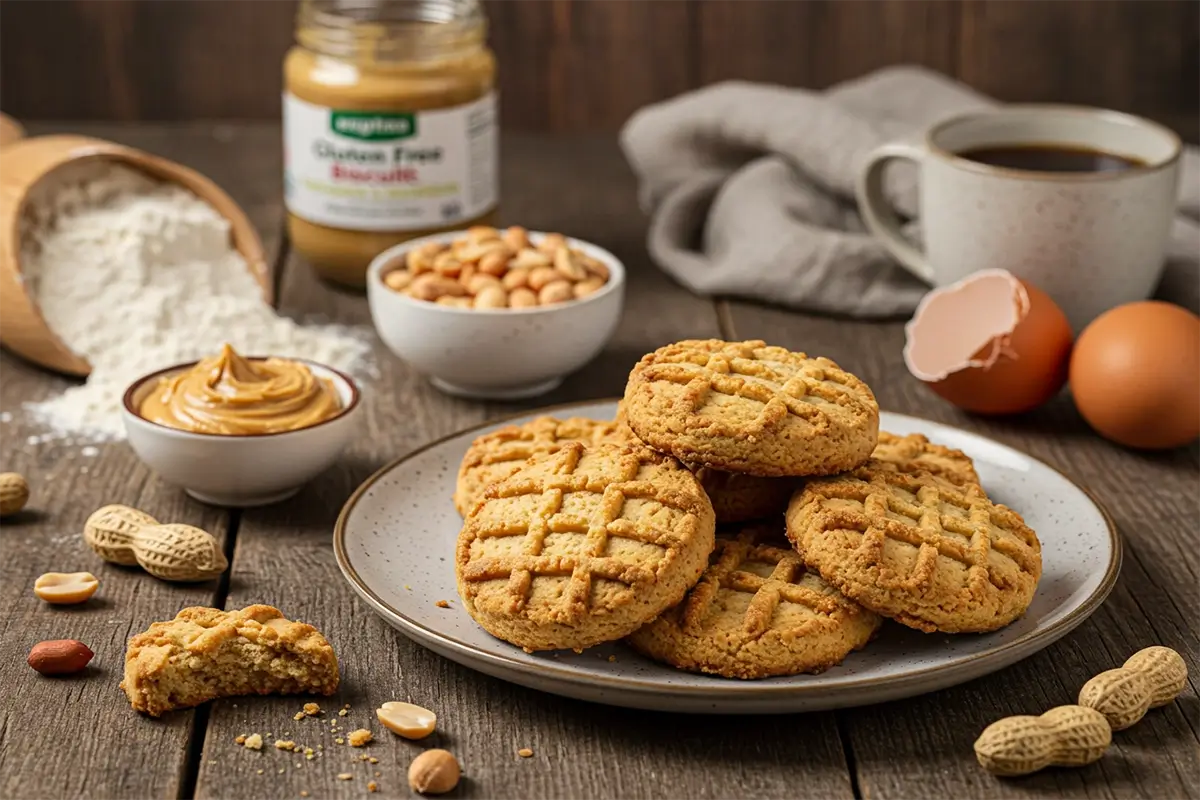Imagine the comforting aroma of freshly baked biscuits wafting through your kitchen. For anyone following a gluten free lifestyle, the idea of enjoying something as simple and satisfying as a peanut biscuit might feel out of reach. But what if you could bake a batch of these mouthwatering treats that are both safe for your diet and absolutely delicious? This article will guide you through the world of gluten free peanut biscuits, from understanding their benefits to creating your perfect batch at home.
Table of Contents
What Makes Gluten Free Peanut Biscuits Stand Out?
The Growing Popularity of Gluten Free Baking
Over the past few years, gluten free baking has taken center stage in the culinary world. Whether you’re avoiding gluten due to celiac disease, gluten intolerance, or simply to explore healthier dietary options, the benefits are undeniable. Gluten free diets can help reduce inflammation, improve digestion, and boost energy levels.
Peanut biscuits fit perfectly into this trend, offering a wholesome, protein-packed snack that doesn’t skimp on flavor. Unlike many gluten free products that compromise on taste and texture, these biscuits prove you can have the best of both worlds.
Peanuts: The Nutty Secret to a Great Biscuit
Why peanuts? It’s simple. Peanuts bring a rich, nutty flavor that complements gluten free baking beautifully. They’re loaded with nutrients like protein, healthy fats, and antioxidants, making them a guilt-free indulgence. Plus, the natural oils in peanuts help create a moist and tender texture in your biscuits, which can sometimes be tricky to achieve in gluten free recipes.
How to Make Gluten Free Peanut Biscuits from Scratch
Baking gluten free peanut biscuits at home is easier than you think. Let’s break it down into manageable steps.
Gathering the Ingredients
The success of your biscuits starts with using the right ingredients. Below is a detailed table for quick reference:
| Ingredient | Quantity | Notes |
|---|---|---|
| Gluten free flour blend | 2 cups | Ensure it’s certified gluten free. |
| Baking powder | 1 tsp | Adds lightness to the dough. |
| Peanut butter | 1 cup | Opt for natural, unsweetened types. |
| Sugar | ¾ cup | Adjust based on sweetness preference. |
| Eggs | 2 large | Acts as a binding agent. |
| Vanilla extract | 1 tsp | Optional, for added depth of flavor. |
| Salt | Pinch | Enhances the overall taste. |
Step-by-Step Instructions for Making Gluten Free Peanut Biscuits
1. Preheat and Prep
Start by preheating your oven to 350°F (175°C). This ensures that the oven reaches the ideal temperature for even baking. While the oven is heating, prepare a baking sheet by lining it with parchment paper. The parchment paper prevents the biscuits from sticking and makes cleanup much easier. If you don’t have parchment paper, a light greasing of the baking sheet with oil or butter will also work.
2. Mix Dry Ingredients
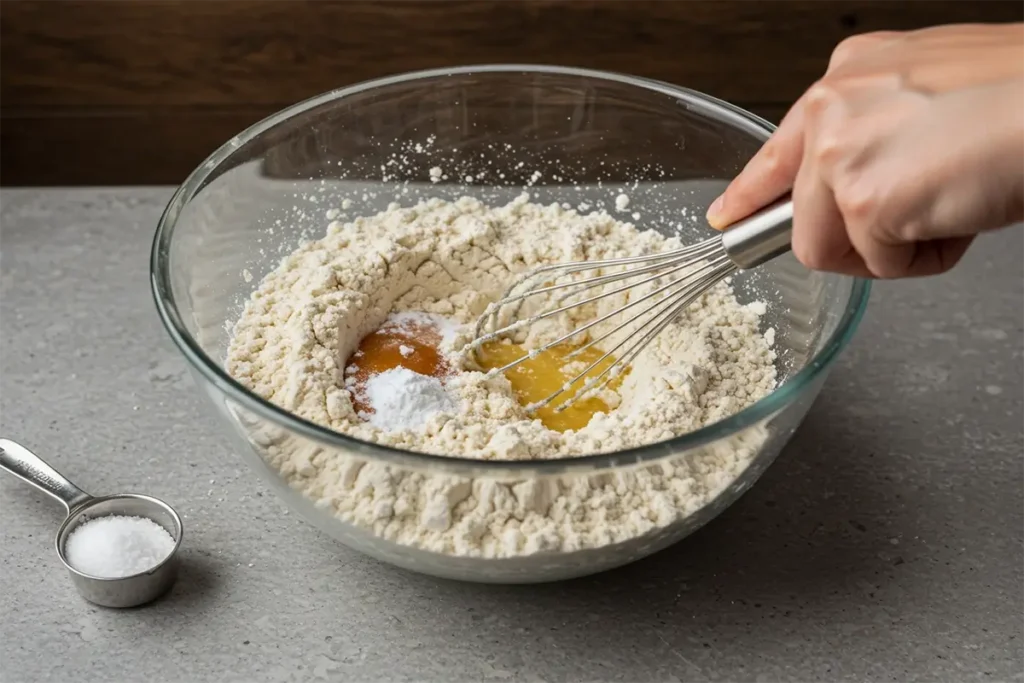
In a medium-sized mixing bowl, combine your dry ingredients:
- Gluten free flour blend: This acts as the base of your biscuit dough. Make sure to use a certified gluten free brand to avoid contamination.
- Baking powder: This helps the biscuits rise slightly and creates a light texture.
- Salt: Just a pinch is enough to enhance the overall flavor of the biscuits.
Whisk these ingredients together to ensure the baking powder and salt are evenly distributed throughout the flour. This step is crucial for achieving consistent texture and flavor.
3. Combine Wet Ingredients
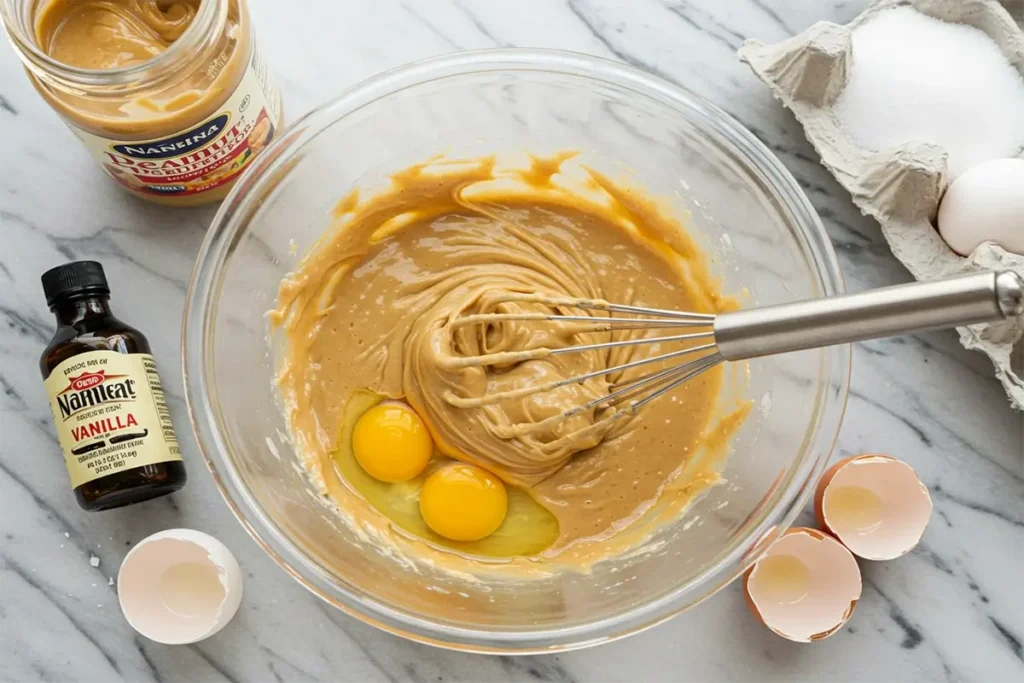
In a separate, larger bowl, combine the following wet ingredients:
- Peanut butter: Use smooth or chunky, depending on your texture preference. Natural peanut butter without added sugar works best for a healthier option.
- Sugar: This provides sweetness to balance the nuttiness of the peanut butter. You can adjust the quantity based on your desired sweetness.
- Eggs: These act as a binding agent, holding the ingredients together. Ensure the eggs are at room temperature for easier mixing.
- Vanilla extract: This optional ingredient adds a subtle depth of flavor.
Use a whisk or a hand mixer to blend these ingredients until the mixture is smooth and creamy. Make sure the sugar is fully dissolved, as this will help create a consistent texture in your biscuits.
4. Bring It Together
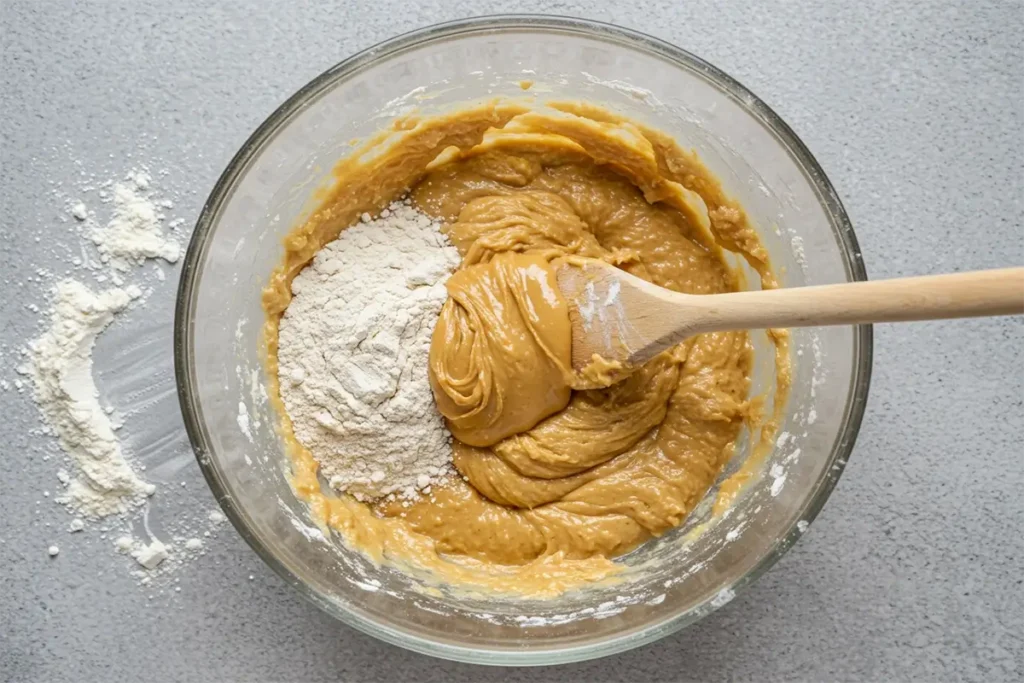
Now it’s time to combine the dry and wet ingredients. Gradually add the dry mixture into the wet mixture, a little at a time, while stirring gently with a spatula or wooden spoon. Continue mixing until the dough comes together into a soft, cohesive ball. The dough should not be too sticky but should hold its shape. If it’s too dry, you can add a tablespoon of milk (or a non-dairy alternative) to help bring it together.
5. Shape and Flatten
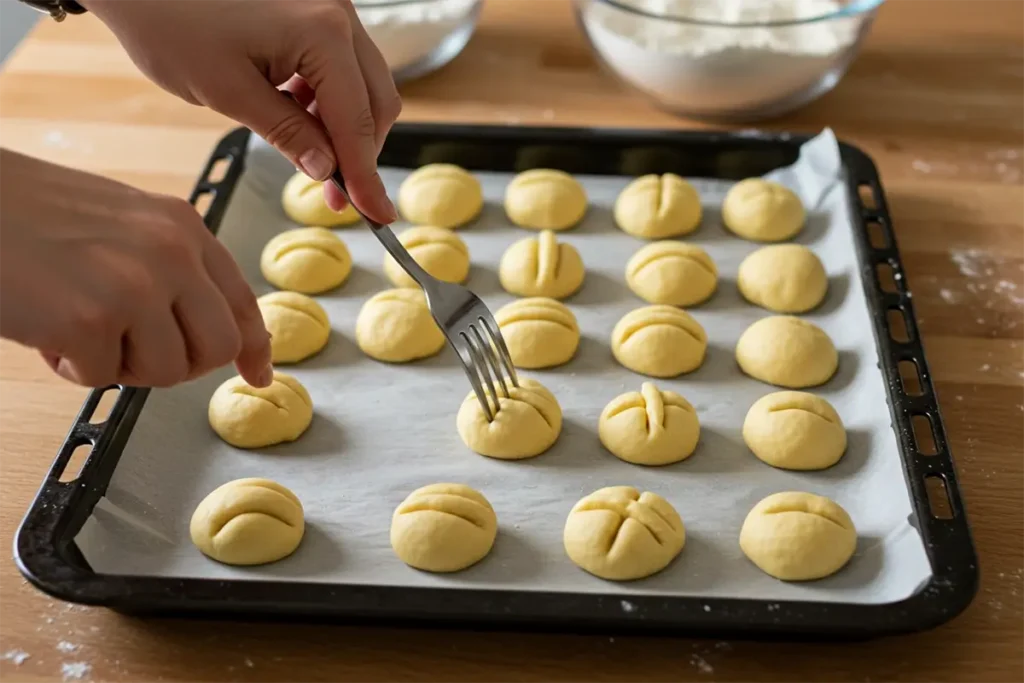
Once your dough is ready, start shaping it into small balls. Aim for balls about 1 inch in diameter to ensure even baking. Place each dough ball on the prepared baking sheet, leaving some space between them as the biscuits will spread slightly during baking.
Using a fork, press down gently on each dough ball to flatten it slightly and create a crisscross pattern. This not only adds a decorative touch but also helps the biscuits bake evenly. Dip the fork in water or sprinkle it with a bit of sugar to prevent sticking.
6. Bake
Place the baking sheet in the preheated oven and bake for 10-12 minutes. Keep an eye on the biscuits as they bake; you’re looking for the edges to turn a light golden color. Avoid overbaking, as this can make the biscuits too dry.
Once baked, remove the baking sheet from the oven and let the biscuits cool for 5-7 minutes. This resting time allows the biscuits to firm up, making them easier to transfer. Finally, move the biscuits to a wire rack to cool completely. Cooling on a wire rack prevents them from becoming soggy on the bottom.
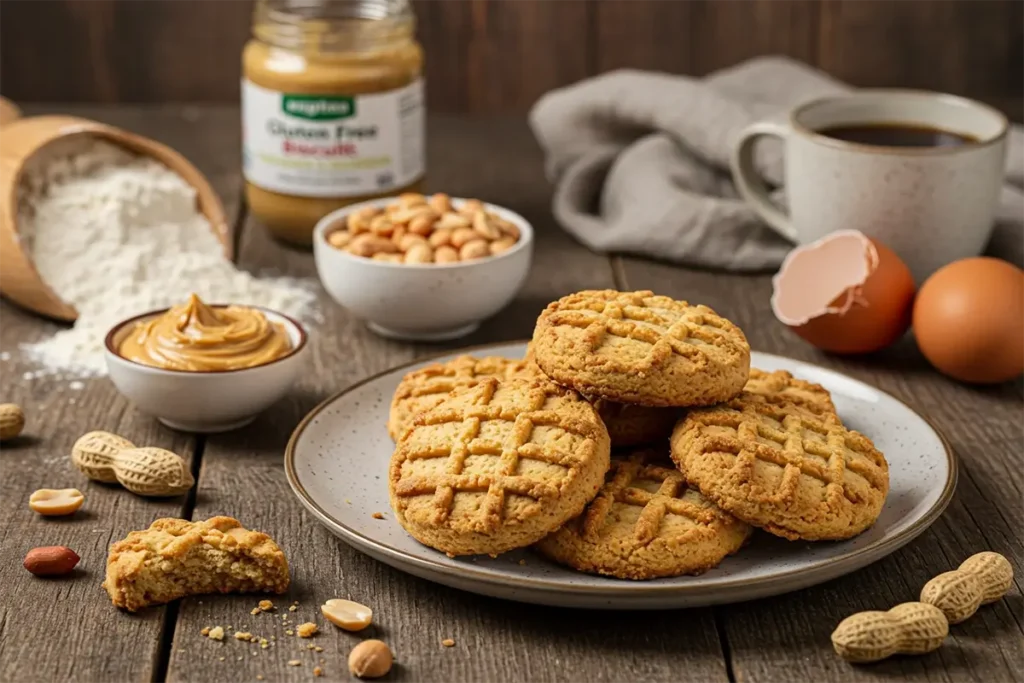
Enjoy your perfectly baked gluten free peanut biscuits! They’re now ready to serve or store for later.
Tips for Baking the Perfect Gluten Free Peanut Biscuits
Substitutions to Try
- Almond Butter Alternative: Swap peanut butter for almond butter for a slightly different flavor profile.
- Natural Sweeteners: Replace sugar with honey or maple syrup for a healthier twist.
Enhancing Texture
- Chilling the Dough: For firmer biscuits, refrigerate the dough for 30 minutes before shaping.
- Creative Add-Ins: Mix in chocolate chips, shredded coconut, or chopped peanuts for added texture.
Serving Suggestions for Every Occasion
Gluten free peanut biscuits are incredibly versatile and can be enjoyed in various ways.
Pairings to Elevate Your Snack Time
- Serve with a hot cup of coffee, tea, or a glass of cold almond milk.
- Use as a base for mini ice cream sandwiches for a delightful dessert.
Perfect for Gifting
Package these biscuits in decorative tins or mason jars for a thoughtful, homemade gift that everyone will love.
Storing Your Biscuits
- Short-Term: Store in an airtight container at room temperature for up to a week.
- Long-Term: Freeze in a sealed bag for up to three months. Thaw at room temperature before serving.
Is Peanut Butter Gluten-Free?
Peanut butter, in its natural form, is inherently gluten-free because it is made from peanuts and sometimes a small amount of salt. However, not all peanut butter brands are gluten-free. The issue arises when manufacturers add ingredients such as flavorings, stabilizers, or emulsifiers, which may contain gluten. Cross-contamination during processing in facilities that also handle gluten-containing products can be another concern.
To ensure your peanut butter is gluten-free, always check the label for certification. Look for phrases such as “Certified Gluten-Free” or “Contains No Gluten Ingredients.” Additionally, opt for natural peanut butter brands with simple ingredients like peanuts and salt.
Which Supermarket Biscuits Are Gluten-Free?
If you’re looking for gluten-free biscuits at the supermarket, the options are growing every day. Many major brands and specialty gluten-free producers offer a variety of choices that cater to dietary needs without sacrificing flavor. Some popular options include:
- Nairn’s Oat Biscuits: Made with gluten-free oats, these biscuits are perfect for snacking and come in various flavors like chocolate chip and ginger.
- Schär Biscuits: A trusted name in gluten-free products, Schär offers a range of biscuits, including shortbread and chocolate-covered varieties.
- Simple Mills Almond Flour Cookies: Made with almond flour and natural ingredients, these cookies are a great gluten-free alternative.
- Mary’s Gone Crackers Cookies: These are both gluten-free and organic, offering a healthier option for biscuit lovers.
Always read the label to confirm gluten-free certification, as brands may vary by region or supermarket.
What Flour is Best for Gluten-Free Cookies?
Choosing the right flour is crucial for baking gluten-free cookies. The key is finding a flour that mimics the texture and taste of traditional wheat flour. Here are some popular options:
- Almond Flour: Made from finely ground almonds, this flour adds a nutty flavor and moist texture to cookies. It’s also high in protein and healthy fats.
- Rice Flour: A versatile and widely available gluten-free flour, rice flour works well in cookies when combined with other gluten-free flours.
- Coconut Flour: While coconut flour is incredibly absorbent, it can be balanced with other flours for a chewy, flavorful cookie.
- Gluten-Free Flour Blends: Many brands now offer pre-mixed gluten-free flour blends that include ingredients like rice flour, tapioca starch, and potato starch for a well-rounded result. Bob’s Red Mill and King Arthur Flour are popular options.
When using gluten-free flour, incorporating binding agents like xanthan gum or guar gum can help replicate the elasticity of gluten, resulting in better texture and structure.
Which Peanut Butter Brands Are Gluten-Free?
Several peanut butter brands are certified gluten-free, ensuring they are safe for those with gluten sensitivities or celiac disease. Here are a few trusted options:
- Skippy Natural Peanut Butter: This popular brand offers gluten-free options with no added preservatives or artificial flavors.
- Smucker’s Natural Peanut Butter: Known for its simple ingredients, Smucker’s provides a range of gluten-free peanut butter products.
- Justin’s Nut Butter: This brand features a variety of gluten-free options, including almond and peanut butter spreads.
- Crazy Richard’s Peanut Butter: Made with 100% peanuts and nothing else, this brand is a great choice for gluten-free baking.
- Teddie Peanut Butter: A certified gluten-free option made with minimal processing and no added sugars.
When shopping, always look for a gluten-free certification seal and read the label to avoid potential gluten-containing additives or cross-contamination issues.
Incorporating Gluten-Free Insights into Baking
Understanding the nuances of gluten-free ingredients, from peanut butter to flours, allows you to create biscuits that are not only safe but also delicious. By selecting certified gluten-free products and experimenting with different flour combinations, you can elevate your baking to new heights. Whether you’re crafting your biscuits at home or exploring store-bought options, the wealth of gluten-free resources ensures that indulgence and dietary restrictions can happily coexist.
Exploring Gluten Free on a Shoestring Cheesecake Cookies
If you’re already diving into the world of gluten free baking with peanut biscuits, why not expand your repertoire with another irresistible treat? Gluten free on a shoestring cheesecake cookies are a game-changer for anyone who loves the creamy richness of cheesecake combined with the convenience of a cookie. These cookies use cost-effective ingredients like cream cheese, gluten free graham cracker crumbs, and simple pantry staples, making them budget-friendly without sacrificing flavor.
Why They’re Worth Trying
- Affordable Ingredients: Baking gluten free doesn’t have to break the bank. With minimal yet flavorful components, you can whip up a batch of these cookies on a budget.
- Unique Texture: Imagine a cookie that’s crisp on the outside and soft, almost creamy, on the inside—perfect for cheesecake lovers.
- Endless Variations: Add chocolate chips, a dollop of jam, or even a swirl of peanut butter to customize them to your taste.
These cheesecake cookies pair beautifully with your gluten free peanut biscuits, offering a complementary treat for parties, gifting, or indulgent snack sessions. By mastering these recipes, you’ll be well-equipped to create an impressive and versatile gluten free dessert spread.
FAQ: Everything You Need to Know About Gluten Free Peanut Biscuits
Are gluten free peanut biscuits healthier than traditional ones?
Yes! These biscuits offer the benefits of being gluten free while also being rich in protein and healthy fats, thanks to the peanuts.
Can I make these biscuits vegan?
Absolutely. Simply replace the eggs with flaxseed or chia seed gel. You can also use plant-based peanut butter.
What makes gluten free biscuits different in taste and texture?
Gluten free biscuits can sometimes be denser or crumblier than their traditional counterparts. However, the right combination of ingredients, like natural peanut butter and gluten free flour, ensures they remain soft and flavorful.
Conclusion
Gluten free peanut biscuits are more than just a snack—they’re a symbol of how inclusive and innovative baking can be. Whether you’re managing dietary restrictions or simply looking to try something new, these biscuits are a surefire way to impress your taste buds and those of your loved ones.
Why wait? Head to your kitchen, gather the ingredients, and experience the joy of baking these delightful treats. Don’t forget to share your creations and inspire others to explore the magic of gluten free baking. Happy baking!

